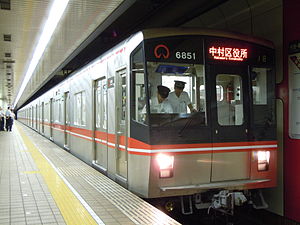Nagoya Municipal Subway 6050 series
You can help expand this article with text translated from the corresponding article in Japanese. (July 2022) Click [show] for important translation instructions.
|
| Nagoya Municipal Subway 6050 series | |
|---|---|
 Set 6151, July 2010 | |
| In service | July 2010 – present |
| Manufacturer | Nippon Sharyo |
| Constructed | 2010–2017 |
| Entered service | 5 July 2010 |
| Number in service | 20 vehicles (4 sets) (as of 1 April 2011)[1] |
| Formation | 5 cars per trainset |
| Capacity | 713 (243 seated) |
| Operators | Transportation Bureau City of Nagoya |
| Lines served | Sakura-dōri Line |
| Specifications | |
| Car body construction | Stainless steel |
| Car length | 20,000 mm (65 ft 7 in) |
| Width | 2,746 mm (9 ft 0.1 in) |
| Doors | 4 pairs per side |
| Maximum speed | 75 km/h (47 mph)[2] |
| Acceleration | 3.0 km/(h⋅s) (1.9 mph/s) |
| Deceleration | 3.5 km/(h⋅s) (2.2 mph/s) (service) 4.0 km/(h⋅s) (2.5 mph/s) (emergency) |
| Electric system(s) | 1,500 V DC |
| Current collector(s) | Overhead line |
| Bogies | SS176M (motored), SS176T (trailer)[2] |
| Safety system(s) | ATC/ATO |
| Track gauge | 1,067 mm (3 ft 6 in) |
The Nagoya Municipal Subway 6050 series (名古屋市交通局6050形) is a rapid transit electric multiple unit (EMU) train type operated by the Transportation Bureau City of Nagoya on the Nagoya Subway Sakura-dōri Line in Japan since July 2010.[2]
The design is based on the earlier 6000 series trains.[3]
Formation[edit]
Trainsets are formed as follows.[4]
| Car No. | 1 | 2 | 3 | 4 | 5 |
|---|---|---|---|---|---|
| Designation | Tc1 | M1 | M2 | M3 | Tc2 |
| Numbering | 6150 | 6250 | 6350 | 6750 | 6850 |
| Capacity Total/seated |
136/45 | 147/51 | 147/51 | 147/51 | 136/45 |
Cars 2, 3, and 4 are each fitted with one single-arm pantograph.[5]
References[edit]
- ^ 私鉄車両編成表 2011 [Private Railway Rolling Stock Formations - 2011]. Japan: JRR. July 2011. p. 98. ISBN 978-4-330-22711-5.
- ^ a b c "名古屋市交通局 6050形(桜通線)" [Nagoya Municipal Subway 6050 series Sakura-dōri Line train]. Tetsudō Daiya Jōhō Magazine. Vol. 39, no. 314. Japan: Kōtsū Shimbun. June 2010. p. 72.
- ^ "名古屋市交通局6050形" [Nagoya Municipal Subway 6050 series]. Japan Railfan Magazine. Vol. 50, no. 590. Japan: Kōyūsha. June 2010. pp. 80–81.
- ^ 名古屋市交通局6050形 [Nagoya Municipal Subway 6050 series]. Rolling stock details (in Japanese). Nippon Sharyo Ltd. Retrieved 14 November 2010.
- ^ 私鉄車両編成表 2010 [Private Railway Rolling Stock Formations - 2010]. Japan: JRR. August 2010. p. 86. ISBN 978-4-330-15310-0.
External links[edit]
Wikimedia Commons has media related to Nagoya Municipal Subway 6050 series.
- Official description (in Japanese)
- Manufacturer's Description (in Japanese)

